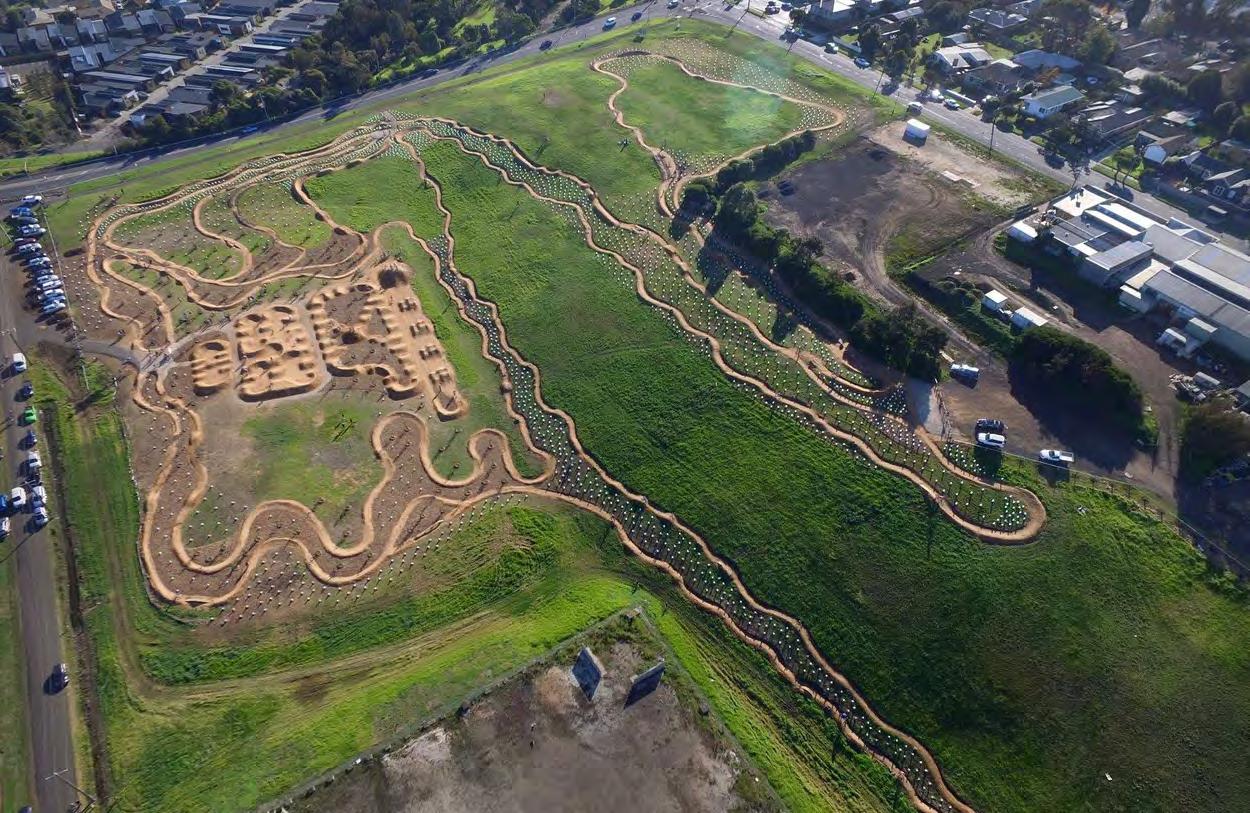
14 minute read
INDUSTRY REVIEW & CURRENT TRENDS
BENEFITS OF CYCLING FACILITIES
It is widely recognised that participation in activities in the outdoors is beneficial for general wellbeing. There are recognised physical, social and emotional benefits in participation in cycling. It is a fun, cheap (after initial outlay costs) and good for the environment. Once mastered, cycling is an easy activity to participate in and can be as intense a workout, or challenge, as is desired.
Recreational cycling facilities create fun and positive atmospheres within communities. Specifically designed facilities introduce a level of challenge into cycling, allowing children through to adults to develop new skills. All ages and all skill levels can generally learn and progress in the same location, gradually building up challenge and intensity. Very young riders can establish competency within a variety of recreational cycling facilities and can be introduced to road safety and traffic controls signals in a safe artificial environment on Learn to Ride tracks. Suburban recreational cycle facilities such as challenge parks can assist in meeting the needs of those seeking opportunities to develop new skills and can be designed specifically to fit into underutilised public open spaces. These facilities create safe local riding environments and can attract new users to participate in cycling sports.
CURRENT PARTICIPATION TRENDS
Cycling is one of the most popular sport and recreation activities in Australia. In Western Australia, nearly 500,000 people (18.5% of the population) ride a bike regularly, with 85% of these people (425,000) riding for sport or recreation rather than transport.10
Wheeled sports have recently shown to be growing in popularity over organised sports. Research, undertaken by the Australian Bureau of Statistics, into children’s participation in sport and physical recreation found that participation rates for physical recreation activities such as skateboarding, bike riding and roller blading were much higher than organised sports (refer table 3). The research also indicated increasing participation rates for both males and females (refer table 4). Note data relating to skateboarding and roller blading in the years 2009 and 2012 also incorporates scooter riding.11 More recent data is yet to be released, however in the years since this study anecdotally the popularity of wheeled sports has continued to grow.
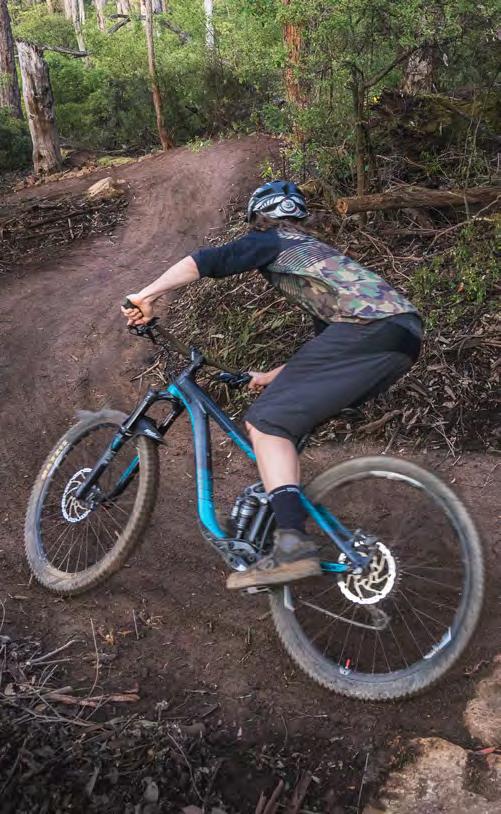
Males
Soccer
Bike riding Skateboarding or roller blading
Females No (‘000) Participation (%)
309.7 21.7
998.8 69.9
857.8 60.0
No (‘000) Participation (%)
Dancing Bike riding Skateboarding or roller blading 367.4 27.1
770.6 56.8
640.0 47.2
Table 4. Growth in wheeled sports participation rates across Australia 2009-2012.
Males No (‘000) Participation (%)
2009 2012 2009 2012
Bike riding 992.5 998.8 66.1 69.9 Skateboarding or roller blading 780.4 857.8 55.9 60.0
Females No (‘000) Participation (%)
2009 2012 2009 2012
Bike riding 721.1 770.6 54.4 56.8 Skateboarding or roller blading 562.2 640.0 42.4 47.2
Participation in BMX racing has increased dramatically since the discipline made its Olympic debut at the 2008 Beijing Games and Australia is now the second largest BMX nation in the world. Membership of BMX Sports Western Australia has more than doubled since 2005 (1,156 members in 2005 2,810 members in 2017).12 BMX club membership in Western Australia has a young demographic, with 72% of riders under 17.13 BMX and pump track facilities are widely recognised as a primary gateway into cycling for young people, with participation building skills, physical attributes and tactical knowledge transferrable to other cycling disciplines.
The sport of mountain biking has continued to see sustained and exponential growth both in Australia and overseas. Anecdotal evidence shows a continuing growth in mountain biking in Western Australia. The current market is dominated by dual suspension all-mountain riders, seeking a broad range of experiences from local urban tracks to more adventurous experiences in natural environments.
There is a notable increase in mountain bike tourism. There are those who travel specifically for mountain biking (enthusiasts), and those that mountain bike whilst on their travels (leisure). The Shire of Esperance does not have the terrain to develop a network to encourage enthusiast visitors, but there is certainly an opportunity to capture the leisure market, and additionally provide great recreational experiences for local residents.
The Western Australian Mountain Bike Strategy identified young people as being underrepresented in mountain bike participation. Increasing availability and accessibility of different styles of trail offering different levels of technical difficulty is one of the recommendations aimed at reducing barriers to participation.14 A spectrum of recreational riding facilities close to town will assist in breaking down participation barriers and make mountain biking more accessible in Esperance. Recreational facilities are trending towards youth precincts and challenge parks. Accessible, multi-faceted and exciting facilities are providing recreational opportunities for participants of all ages. Dedicated facilities for sport and recreation cycling can:
▪ Provide an environment for recreation, training and events that is not affected by other users or activities ▪ Help raise the profile of cycling ▪ Be a home to clubs, organisations and community groups ▪ Host events using simplified event approvals, logistics and management processes ▪ Provide enhanced spectator opportunities ▪ Cater for bike education and skill building
future trends
It is hard to predict long term trends in facilities, but short-term trends can be hypothesized based on current global developments.
Tasmania is actively producing concept plans for mountain biking facilities across the state, to meet local and visitor demand. These trails vary from wilderness trails, aimed at showcasing the natural environment and creating challenging wilderness cycling experiences, through to city mountain bike parks. The mountain bike parks are focusing on a mixture of XC and downhill trails, designed to meet the increased demand for skills progression and challenging experiences. Downhill trails, that require an uplift service create business opportunities. Bike park concepts are also featuring cafes, bike hire and bike shops, showing there is a demand for facilities where trails are being constructed.
Freestyle BMX is about to debut at the next Olympics, expanding on the current BMX racing, which was introduced in 2008. The subsequent growth in BMX since the introduction of racing in 2008 would indicate that there will likely be an increased uptake in freestyle BMX. A pump track facility is the ideal environment to create freestyle BMX opportunities. The likely increase in freestyle BMX participation should be taken into account when designing future pump tracks.
Freestyle BMX competitions may increase in popularity and facility design should take this into account, allowing for clear spectator viewing and a sizeable track with an abundance of optional lines and transferable features.
KINGSLEY PUMP AND JUMP, JOONDALUP, WA
Kingley Pump and Jump is a small facility (0.34ha) that contains a pump track, jump lines and a safety track. Open in early 2017 the facility has become a regional attraction with riders travelling large distances to use the facility. The park is often crowded on weeknights and weekends, attracting all ages. This style of facility is easily accessible, attractive to users of all abilities and is an ideal suburban opportunity for skills progression.
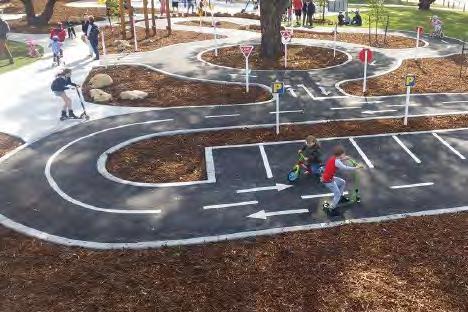
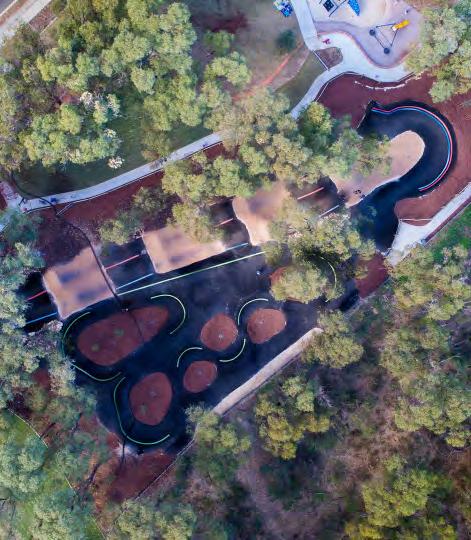

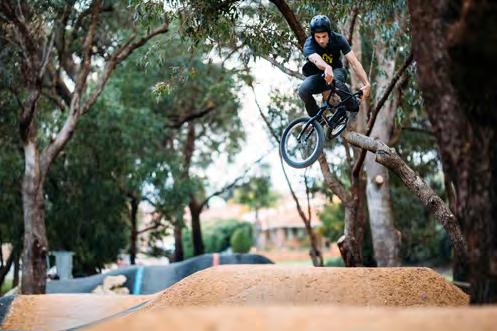

CITY BIKE PARK, ADELAIDE, SA
City Bike Park is located in Adelaide’s CBD. Hand built and maintained by a dedicated crew of volunteers, the park is one of the best known dirt jump trail spots in Australia. This facility is a good example of how the riding community can be effectively engaged to activate and enhance public space.
Originally built in 2004, the park has been through a number of phases of redesign, coming from a competition based facility to more of an allinclusive recreation facility with jumps to suit beginners, intermediate and advanced riders. The park has been designed, built and managed by a dedicated group of volunteers, until 2017 when the Adelaide City Council raised some concerns regarding insurance. Negotiations resulted in the volunteer crew being retained and a third party trail building company engaged for safety assessment/auditing and an operational framework put in place. Adelaide City Council provide ongoing support in the form of tools and supplies.
Management of the jumps also involves watering before use, covering and chaining when not in use and restricting and monitoring use after rainfall events; all tasks which are undertaken by volunteers.
The success of City Bike Park is primarily due to the enthusiasm and dedication of a few individuals within the community and also the support from the City of Adelaide. For further information on the history of City Bike Park refer to www.citydirtcrew.com.
While the level of community interest in a cycle facility in Esperance would suggest that a similar community led jumps line could be feasible, ongoing commitment to maintain is unknown.

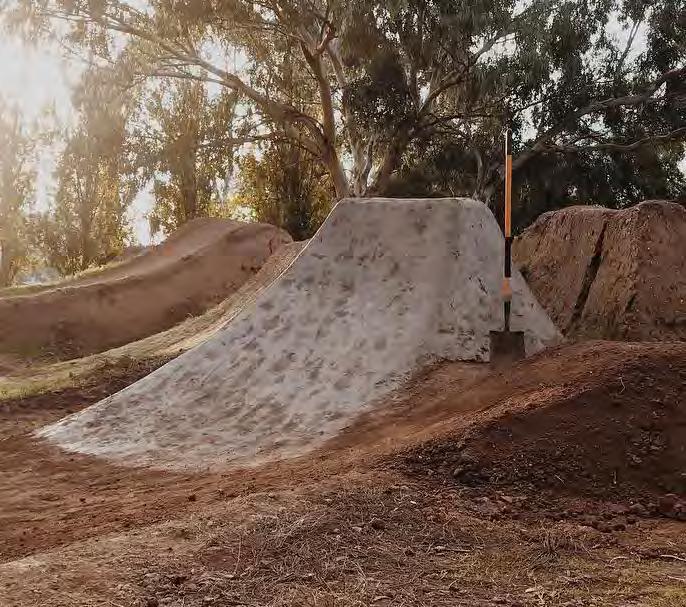
City Bike Park. Image source: www.citydirtcrew.com
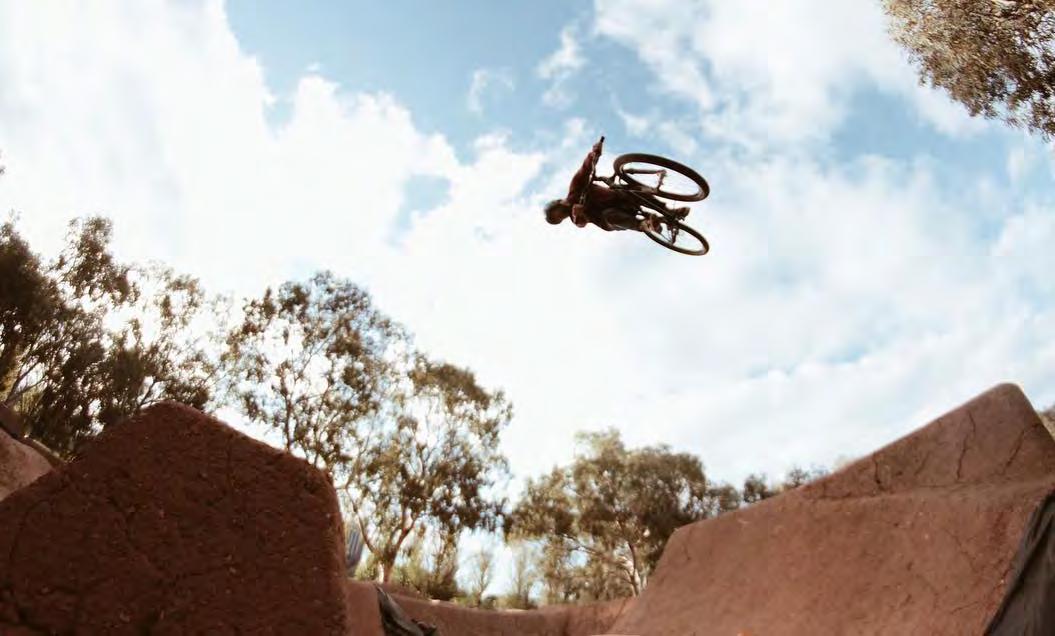
CHAPMAN RIVER, GERALDTON, WA
Spalding Park Mountain Bike Hub is situated on the Chapman River, 6km north of Geraldton CBD. The hub consists of a variety of riding experiences catering for riders of all ages and all abilites.
There is a jump track, with progressive jump lines from green through to black. The jump track connects onto a large figure-eight pump track with multiple lines and transferable features. A skills loop connects straight into the jump and pump track area.
The skills loop has plenty of features to keep repeat visitors entertained. There are log rollers, log rides, rock drops, rock gardens, elevated drops, descending turns and climbing turns with inside technical lines to challenge the more advanced rider.
The tracks and skills loop are complemented by a connecting 12km blue XC trail, allowing riders to take their skills out onto the open trail. The trail is dual direction and technical features along the trail keep riders engaged, and distance provides the exercise challenge that many are seeking. The trail is also utilised by walkers and there is clear trail etiquette signage.
This trail hub is a volunteer maintained all rounder, servicing a large proportion of the local mountain biking community and visitors to Geraldton.
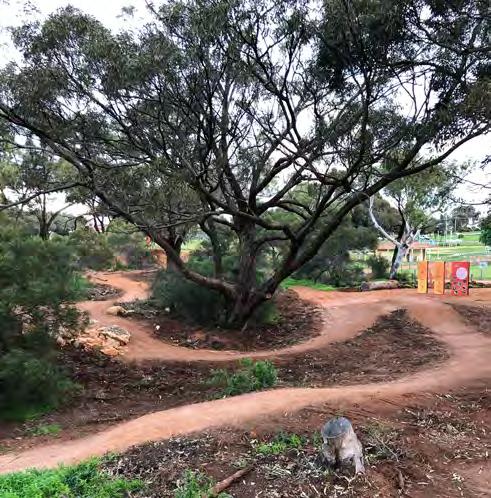

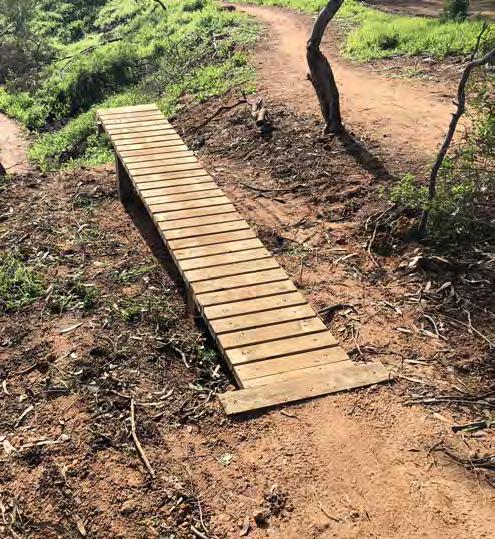

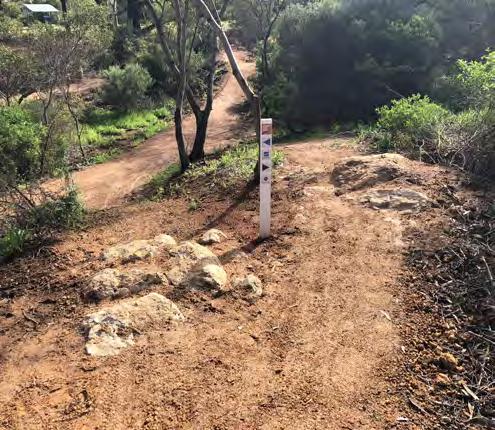
The Great Southern has very little existing designated recreational cycling facilities. Apart from The Piggery, the nearest sanctioned mountain bike trails are in Albany, 480km to the west. Mount Clarence has a small network of XC and downhill trails, and the City of Albany are currently working towards a youth precinct, incorporating a pump track, mountain bike jump lines, community managed dirt jump lines, a skate bowl, skate plaza, and picnic and playground amenities.
The Denmark to Nornalup Heritage Rail Trail is a multi-use 54km trail connecting Nornalup to Denmark along an easy coastal trail. This is a family friendly experience and is considered a touring trail, rather than a challenging mountain biking experience.
To find a more challenging experience riders are required to travel outside of the Great Southern to Northcliffe, Margaret River, Dunsborough, Pemberton and further afield to the Perth and Peel region. Albany is the southern terminus for the Munda Bidi trail, which spans 1,060km to Mundaring, Perth. The Esperance Cycle Plan 2050 identifies an opportunity to continue the Munda Bidi trail from Albany to Esperance, and then extend the touring trail from Esperance townsite out to Cape le Grande National Park. This long term aspiration would be an excellent addition to the already successful trail between Perth and Albany. Planning and financing long distance trails can be a lengthy process, as there are many difficult constraints to navigate. A project of this magnitude will take many years to come to fruition.
Urban recreational cycling facilities are becoming a popular choice for small regional communities. Many small communities are building pump track facilities alongside skate parks and identifying suitable locations for mountain bike trails within their jurisdiction. Popular recently constructed examples include Dwellingup and Boddington. Beverly, York, Exmouth and Tom Price are additional regional Western Australian examples of small communities developing recreational cycling facilities. Regional master planning is a recommendation within the Western Australian Strategic Blueprint. This level of planning identifies region wide mountain biking opportunities. Localised trails masterplans then assist with developing sustainable interlinked trail networks within local communities. Table 5. Existing cycling facilities
FACILITY SCALE SITE SIZE TYPE LOCAL GOVERNMENT
MTB TRAILS/ NETWORKS Munda Biddi
1060km N/A Touring/ XC Numerous Albany – Mt. Clarence 0.7km ~ 242Ha Downhill City of Albany Denmark – Nornalup Rail Trail 54km N/A Rail Trail Shire of Denmark
The Piggery Northcliffe – Aroundtu-it 14.5km ~ 87Ha XC
5.7km ~ 134Ha XC
Pemberton – MTB Park 30km ~ 120Ha XC, Skills Loop, Dirt Jumps
REGIONAL RECREATIONAL CYCLING FACILTIES Shire of Esperance Shire of Manjimup
Shire of Manjimup
Adventureland Park
Skroly Park - decomisisoned ~ 0.15Ha Learn to ride Shire of Esperance ~ 1Ha Velodrome Shire of Esperance
Gaps in facility provision in esperance
600 km
Perth
500 km
Dwellingup
400 km
Collie
Margaret River Munda Biddi
Pemberton
Northcliffe
Denmark
Albany
300 km
200 km
100 km
Esperance
FACILITY GAP IN PROVISION
XC The existing facility, The Piggery, is not meeting the needs of the broader mountain biking community and the current trends in XC riding. There is a desire for XC trails that provide progressive challenge and integrate with other elements such as jump tracks, and/ or skills loops. The Piggery site offers opportunity to re-assess the alignment of trails to make better use of the sites elevation range. Alternative sites with larger elevation changes will allow for more advanced features and further skills development. BMX There are no facilities for BMX racing in Esperance. The public survey and community consultation did not uncover a large desire for BMX facilities, but riders were known to use the old skate park facility and would benefit greatly from a cycle friendly pump track inclusion in the Esplanade Youth Precinct development. Downhill There are un-sanctioned trails displaying a desire for this style of riding in Esperance. The current location of Dempster Head is not appropriate in its current form and only provides a very short steep single descent. An alternative location that can be developed to meet the needs of the broader community is recommended. A location that allows for introductory trails through to advanced downhill riding is advisable.
Pump Track There are currently no pump track facilities in Esperance. There are considerations within the Esplanade Youth Precinct concept design. Common Ground recommend investing in a facility that will meet the growing demand for recreational cycling facilities and the growing desire to increase bike handling skills. Investing in larger pump tracks with multiple transfer features, optional lines and spectator access will allow for inclusion of all wheeled sports within the facility and keep regular visitors engaged. Options for hosting events in these spaces should also be considered in design. Jump Track There is evidence of unsanctioned jumps being constructed in isolated pockets around the townsite. Inclusion of jump track facilities into recreational cycling facilities should be considered. Jump tracks offer skills progression opportunities and exhilarating riding experiences for thrill seekers.
Skills Track There was evidence within the survey results and community consultation that there is a desire for opportunities to increase skill levels. The new “learn to ride” facility next to Adventure Land Park is a good introductory experience for small children learning how to ride a bike, and learning about riding bikes on public roads, including lane discipline and traffic signals. There is very little beyond this facility that encourages progression in cycling skills. Touring Research and recent online surveys show that there are many people utilising the road networks in Esperance for cycling. There are currently no off-road longer distance options for cycling and mountain biking. The upgrades to Pink Lake Rd dual use path would allow for the consideration of a longer riding route, where mountain biking trail options could be incorporated into the design. As outlined in the Esperance 2050 Cycle Strategy, a touring trail connecting Cape Le Grande to town, and the eventual extension of the Munda Biddi from Albany through to Esperance would fill the gaps in longer distance riding opportunities within the Shire.
Summary
Cycle participation is increasing, and demand for more recreational cycle facilities is evident from existing facility use across Western Australia, interstate and globally. There is a desire within the local Esperance community for a range of facilities to accommodate beginners through to advanced riders, with facilities that allow for skills progression and additional challenge.
Esperance has a wide demographic, with many seasonal visitors, that would benefit from a variety of cycling opportunities spread across the townsite and interlinked by cycle paths and dual-use trails.
The Great Southern region lacks opportunities for participation in cycling sports. As identified in the Esperance Cycle Plan 2050, cycling should be incorporated into strategic planning.
Three basic objectives to consider in future planning include, the provision of safe cycling routes, a variety of skills development options and mountain biking trails to meet the ranging abilities of the growing mountain biking population.






